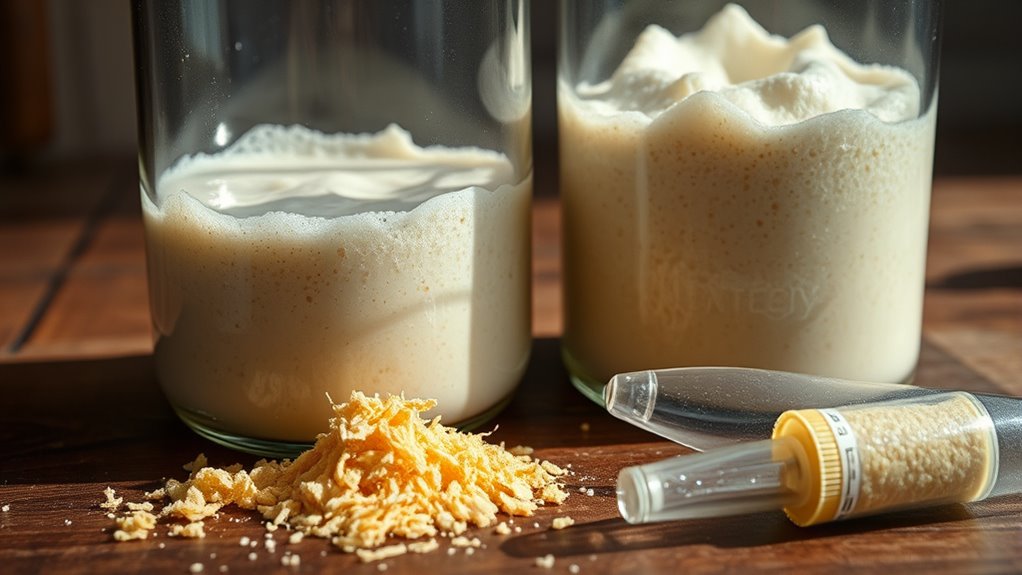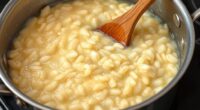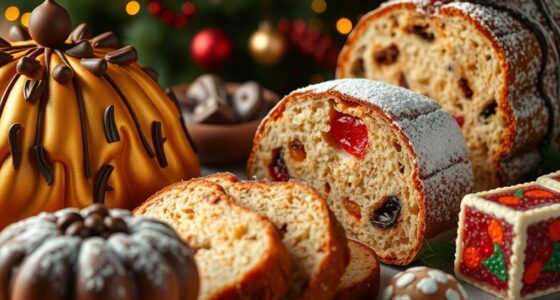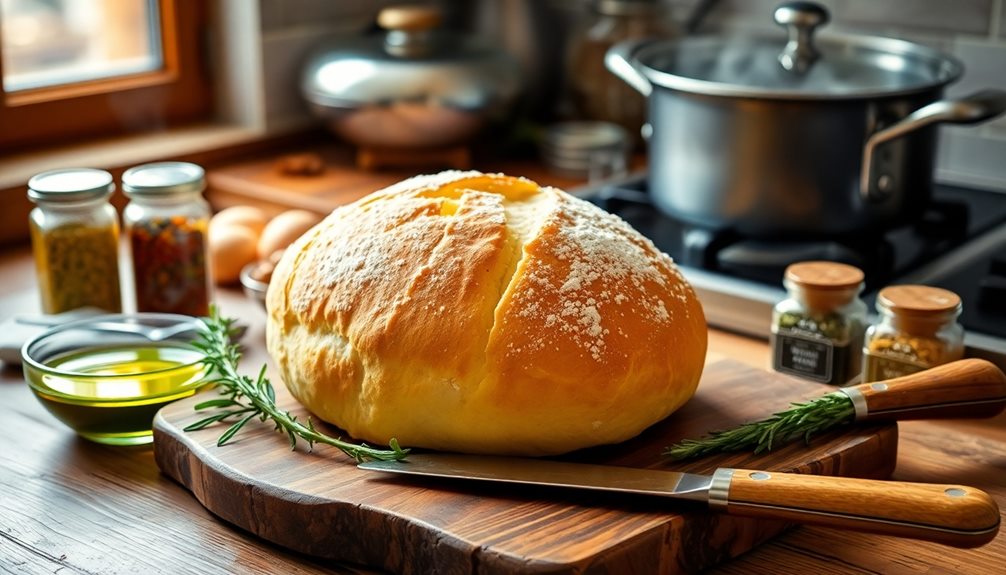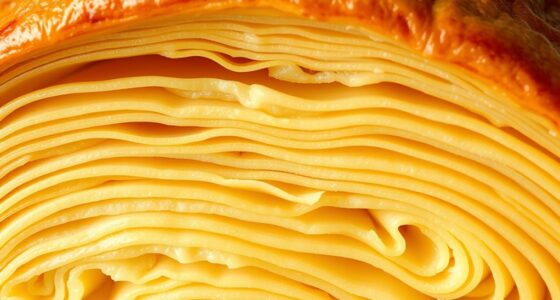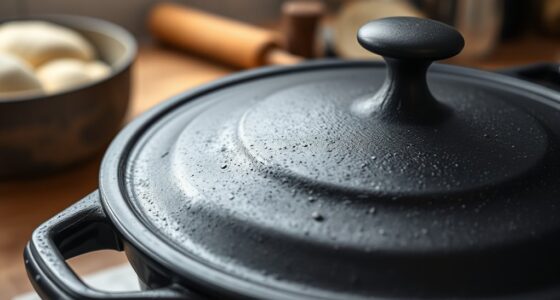By harnessing oxygen, wild yeast, and patience, you can craft authentic sourdough bread without commercial starters. Start by creating a natural levain with flour and water, allowing exposure to ambient oxygen which encourages beneficial microorganisms to grow. Regular feedings and long fermentation times develop your culture’s flavor and strength. Embracing this traditional process results in a vibrant, flavorful bread deeply connected to ancient baking techniques—continue to explore these methods to deepen your sourdough craft.
Key Takeaways
- Exposing the flour-water mixture to ambient oxygen encourages wild yeast and beneficial bacteria growth essential for natural fermentation.
- Oxygen intake supports the development of a lively, resilient culture without relying on commercial starters.
- Proper timing and patience allow the natural microflora to establish, develop flavor, and strengthen the sourdough culture.
- Regular feedings with fresh flour and water nurture the culture’s growth, enhancing fermentation efficiency and bread flavor.
- Long fermentation times and gentle handling develop gluten structure and complex flavors, emphasizing natural processes over shortcuts.

Artisanal sourdough making is a craft that combines patience, skill, and a deep appreciation for traditional baking. When you decide to craft sourdough without relying on commercial starters, you’re engaging with fermentation science in its most authentic form. Instead of using pre-made yeast, you harness the natural yeasts and bacteria present in your environment, cultivating a wild, lively culture through simple, time-honored techniques. This process not only deepens your connection to traditional baking methods but also offers you control over every aspect of your bread’s development.
The foundation begins with understanding how fermentation works. You’ll start by creating a levain—an initial fermentation mixture—using just flour and water. By exposing this mixture to ambient oxygen, you encourage the growth of wild yeast and beneficial bacteria. Oxygen plays a fundamental role here, as it helps these microorganisms flourish, transforming your mixture into a vibrant culture that’s full of life. As fermentation progresses, you’ll notice bubbles forming and the mixture developing a tangy aroma, signs that your natural culture is developing strength. This process embodies traditional techniques that have been passed down through generations, relying solely on what nature provides.
To succeed, you need patience. Unlike commercial starters that are quick to activate, your natural culture takes time to mature. During this period, you’ll perform regular feedings—adding fresh flour and water—to nurture the yeast and bacteria. Each feeding refreshes the culture, encouraging the growth of desirable microorganisms while suppressing unwanted ones. As you observe the rising and falling of your levain, you develop a keen understanding of how fermentation science manifests in real time. This hands-on approach allows you to fine-tune your process, adjusting feeding schedules or hydration levels based on how your culture behaves.
Once your culture is lively and robust, you incorporate it into your dough, leveraging traditional techniques like gentle folding and long fermentation times. These methods develop gluten structure and flavor complexity, giving your bread its characteristic texture and depth. Because you’re working with natural fermentation, the flavor profile varies depending on your environment, flour choice, and fermentation duration. This variability is part of what makes artisanal sourdough so unique and personal.
In essence, creating sourdough without a commercial starter is a journey into fermentation science and traditional techniques. It’s about understanding the natural processes, respecting the time they require, and embracing the unpredictability that results in a truly handcrafted loaf. This approach not only yields bread with exceptional flavor and texture but also connects you to centuries of baking tradition rooted in patience, oxygen’s essential role, and the power of wild fermentation.
Frequently Asked Questions
Can I Bake Sourdough Without Any Commercial Ingredients?
You can definitely bake sourdough without commercial ingredients. Instead, focus on cultivating your own sourdough starter from natural methods, like capturing wild yeast and bacteria from your environment. This approach allows for better sourdough preservation and helps maintain flavor consistency over time. By nurturing your starter with patience and care, you’ll create a unique, artisanal bread that’s both authentic and free of commercial additives.
How Long Does It Take to Develop a Mature Wild Yeast Culture?
Developing a mature wild yeast culture typically takes about 5 to 7 days, depending on your fermentation timeline and environmental conditions. During this period, you’ll notice signs of yeast maturation, like bubbling and a tangy aroma. Patience is key, as consistent feeding and proper temperature help your wild yeast establish strong fermentation activity. With time, your culture will become robust enough to bake flavorful, artisanal sourdough bread.
Is It Possible to Recreate the Same Sourdough Flavor Consistently?
Think of sourdough baking as painting with flavors—each loaf a unique masterpiece. While perfecting flavor consistency can be tricky, it’s doable with careful attention to your starter’s habits and environment. By maintaining steady fermentation conditions and tracking your sourdough profiles, you can reliably replicate the tang, complexity, and aroma you desire. Over time, your sourdough becomes a familiar friend, consistently delivering that signature flavor you love.
What Are Common Mistakes When Cultivating Wild Yeast Naturally?
When cultivating wild yeast naturally, you should watch out for common fermentation pitfalls like inconsistent feeding schedules, which can hinder yeast growth. Contamination risks are also high if you don’t keep your environment clean, leading to unwanted bacteria or mold. Make sure to use clean utensils and containers, monitor temperature and humidity, and avoid opening your starter unnecessarily. Staying vigilant helps guarantee a healthy, active culture and successful fermentation.
Can I Use Tap Water or Should I Use Filtered Water?
You should use filtered water instead of tap water for your sourdough starter. Tap water’s water quality can vary, often containing chlorine or chloramine, which can inhibit wild yeast growth. Additionally, mineral content in tap water may interfere with fermentation. Filtered water provides a cleaner, more consistent environment, allowing your wild yeast to thrive and ensuring healthier, more reliable sourdough development.
Conclusion
Think of your sourdough journey as tending a delicate garden; with patience, oxygen, and time, your wild yeast blooms into a vibrant, living masterpiece. By embracing the natural process without commercial starters, you’re nurturing something uniquely yours—alive, flavorful, and full of character. Every loaf becomes a tribute to your dedication, a symphony of bubbles and tang. Keep nurturing your sourdough, and watch it flourish into a beautiful, edible work of art.
